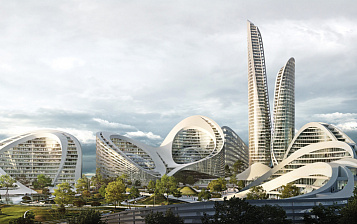An architect must be able to do many things - more than a director in film production. According to many, he should be able to almost everything. However, if you look at the curriculum of the institutes, then most of all - four years - the future builders of houses and cities study "architectural drawing". In the era of complex computer software, however, this is not an anachronism, because the main thing that an architect should know is not proportions and strength of materials, but the ability to work with form through chiaroscuro, to understand how the built house will function every hour during the day and every day in year, delighting those who live or work in it. Maxim Kirsanov, a special correspondent for the Gorproekt magazine, listened to the opinion of industry experts on how competent work with light and space makes it possible to improve the quality of architecture and how the owners solve the issues of exploitation of the resulting “ideal” buildings.
The meaning of light in architecture
Attention to chiaroscuro in architecture exists as long as the construction itself exists. The Egyptian pyramids were not just built for their silhouettes and majestic shadows, but were originally lined with reflective tiles, sparkling like huge spaceships. The inner light courts of Roman villas or the only light window - the "oculus" in the ideal dome of the Pantheon. “Rose windows” and multi-colored stained-glass windows of Gothic cathedrals (their area reached several thousand meters in large temples!), Which, together with a decrease in the number of bearing pillars, brought incredible sensations of “heavenly Jerusalem” to all visitors.
The desire of the human mind to harness the power of light led to the flourishing of electric lighting at the end of the 19th century. At the World's Fair in Chicago, one hundred thousand Edison lamps illuminated 14 pavilions, predicting the image of the city of the future. In Paris in 1900, the most fashionable object was the "Palace of Electricity", a massive structure, reminiscent of future Art Deco palaces, 130 meters long and 70 meters high, illuminated by 5000 lamps. We all know that this was only the beginning, and over the next century, the bright night silhouettes of skyscrapers gave us a new kind of aesthetic joy - mesmerizing oceans of night lights, already visible from space.
The Soviet architectural avant-garde, whose heritage we all live in, also sought to bring a literally understood “bright future” to architecture, creating more and more transparent structures from glass and concrete, open to the sun's rays. All of them, from DC them. Zuev, which still adorns the White Square area, to the constructivist stations of the Moscow metro with panoramic windows, for generations instilled in Russians a taste and passion for contrasting chiaroscuro. It can be said that despite political and socio-cultural differences, a Parisian admiring the game of the best among the spiers of the Notre Dame Cathedral and the illumination of Montmartre, and a Muscovite admiring the skyscrapers and glass facades of the Palace of Culture, have a close understanding of light. This is characteristic, because the love of light is genetically inherent in us, and the development of building technologies has only allowed us to bring life closer to the natural and desired level of comfort. Let's evaluate how the technology of working with light is used in mass architecture: residential, retail, office and other.
How light helps us live and work
Light can play a decisive role in the perception of the volume of a building - in many ways, shape, color, rhythm, mass are only derivatives of light (as Le Corbusier aptly puts it). Huge light spaces, both in the interior and exterior, can change the impression of architecture, and most importantly, help people live. The first columns were used to create light wells, which over the course of thousands of years have become an enduring tradition of courtyards, which from Rome to the PIK residential complex on the outskirts of Moscow serve to accumulate light and heat in the house. Soviet urban planners, breaking the habitual development of cities, focused on huge green courtyards, which made the light diffused, but intense, playing differently during the day. Modern dense urban development requires new ways of working with light. Somewhere the proximity to the river is played up (by a natural reflector), somewhere - reflections in neighboring skyscrapers. Many effects work only for a limited time, for example, a through staircase and elevator unit that works in both directions of the house. Once a day for an hour, such a facade begins to play in an unexpected way, giving residents a morning burst of energy or, conversely, a minor evening relaxation.
But what to do when one of the facades of the house faces north (which is inevitable in the context of large renovation projects - for example, within the ZIL residential complex). Such a building can be in the shade for almost the whole day. Without glare of light, even the plastic modern facade becomes flatter and grayer. Faced with a similar challenge, architect Natalya Mastalerzh, a partner at the NOWADAYS office (who worked on the Jewish Museum, City offices, many Moscow restaurants), used stemalite panels deployed at complex angles to solve the problem. Even in a static moment, this material glared, accepting even the weak rays of the sun, which were reflected in different ways, restoring life to the “facade” and improving conditions for the inhabitants of the house.
Work is built differently in office and other workspaces. Ever since the construction of large industrial enterprises in the USA and the USSR, it has been noticed that a well-thought-out installation can improve labor efficiency, and ill-conceived decisions, on the contrary, demotivate workers who spent most of their lives in rooms where the color of walls and furniture, the correct arrangement of windows, coffee machine or lamps - everything affected efficiency. Large corporations, investing in productivity growth, quickly realized how intense, but harmonious attraction of light, can help their goals. The result was the creation of complex atriums and the rise of entire industries associated with the construction and maintenance of facilities. Since the end of the 20th century, volumetric formwork (similar to PSK-CUP, produced in Russia) has been gaining more and more popularity - ideal for a complex second light, prestressing technologies that reduce the number of load-bearing walls and columns (and increase the light transmission of offices and the freedom of their layout) , couplings for fittings that make it possible to make columns ever higher, raising the ceiling visually somewhere “towards the sky” (we described a similar technique in an article about the Sberbank Technopark in Skolkovo), and as a result, the market for lifting equipment (like universal electric GENIE hoists manufactured by TEREX) for maintenance of endless lamps, windows and atriums.
Several generations of modern architects have grown up on these orders: from Oscar Niemeyer, who created brutalist cities flooded with light, to Stephen Hall or Norman Foster. The latter's Commerzbank in Frankfurt am Main and its famous London cucumber Swiss Re insurance company have made giant atriums and huge gardens inside skyscrapers a quality standard that is equally mandatory for builders in Dubai, Düsselbdorf or Krasnogorsk. The gradual introduction of "green technologies" in construction has focused on natural lighting as a way to improve the autonomy of buildings and, as a result, reduce the cost of their maintenance.
As we can see, the importance of light and the positive influence of its aesthetics have won even purely utilitarian, functional venues. The experience of thousands of shopping centers (starting with Milan's Galleria Vittorio Emanuele II) shows that the higher the ceilings of the galleries and the brighter the light in the atrium, the more active and cheerful the buyers will be. Builders of airports, administrations, and stadiums have also seen that wide interior spaces with well-tuned lighting calm visitors and motivate them to come back. As Dmitry Ovcharov, chief architect of Nefa Architects, who worked on metro stations, air terminals, lofts and co-working spaces, noted: “Everything that we do with light, we do for people who just want to live and work in comfortable conditions” .
However, of course, the less massive an object is, the more experiments with different types of light are possible. Briefly describe their palette.
Experiments with different types of light in architecture.
While the Soviet avant-gardists cut through the ever-gloomy Russian atmosphere with the bright contrasting rays of a new generation of public spaces, a similar use of contrasting light was developed by the BAUHAUS school and Le Corbusier, who continued its work. A classic example is the concrete pilgrimage church Notre Dame du Haut, better known as the Ronchamp Chapel. The lighting solution inside it with the play of thin rays passing through extremely narrow windows into diffused twilight, many critics consider it a continuation of the tradition of Pskov churches (which the French classic managed to see while working in the USSR). At the same time, another Frenchman, Pierre Jeanneret, while building another classic of playing with light, the administration of Chandigarh, rethought Roman architecture in a new way, working with light in the spirit of the Roman Pantheon. In many ways, these ideas have already been embodied in our time by the builders of the new complex of the Kremlin Museum on Red Square. The transfer of the priceless relics of the Armory, which are extremely sensitive to light, required twilight in some of the premises, which the designers countered with bright flooded halls and passage galleries.
In the process of the spread of modernist and even postmodernist architecture, contrast lighting began to seem to many to be too rough a decision, and combined light options became increasingly popular, when a mixture of diffused and accented light made it possible to sharpen the emotional content of the space. Almost all major modern museums are like this: from the National Portrait Gallery in Washington with Norman Foster's mesh roof, to the full penumbra of Rem Koolhes' projects (Grazh Museum or Seattle Library). The combination of such techniques with bright contrasting chiaroscuro earned the Pulitzer Prize for the architectural bureau SANAA, which was able to maximize natural light in the building of the Zollverein School of Management and Design. At the same time, thoughtful design made it possible to significantly
to reduce the costs of the school administration for heating, despite the location in Essen in the North of Germany. Increasingly smaller and more complex openings in roofs and walls are a hallmark of modern architecture designed to subjugate and bend light ingeniously. So in the Louvre Abu Dhabi, a huge openwork dome creates a feeling of an open sky and at the same time beats the play of light and shadow of the traditional Arab lattice - the mashrabiya.
In contrast to the above, the average diffuse lighting has also become the standard of construction, including mass construction - for example, country villas, starting with the “glass” Farnsworth House by Mies van der Rohe. After the success of this American classic, the elaboration of scenarios for the behavior of the sun during the day, as well as the characteristic interior configuration, where the evening western light is intended for the living room, and the neutral northern facade is given to working spaces, became the quality standard.
Despite the individual approach to each project, it is noticeable that architects of recent decades have increasingly leaned towards a number of characteristic tricks of playing with light to emphasize their projects. This can be carving out forms and shifting architectural volumes that control the movement of light, creating centers of light (wells through which light spreads vertically), weaving the sun's rays with the help of ingenious openings, or receiving light transmission due to glass and other "transparent" facades.
Finally, one cannot fail to mention the possibility of creating a completely neutral diffused light, with the help of complex, often stepped atriums and light-catching "hoods" on the roof, creating a meditative atmosphere. Such is the Atlanta Exhibition Museum, the Iowa School of Art, the Chinese technoparks, or the upcoming GES-2 art center in Moscow, as well as thousands, if not millions, of other projects whose creators understand the important truth that light is natural or artificial is not an addition to architecture, but an integral part of it.
Forward - to the oceans of light
Naturally, progress is inexorable - and ways to harness natural light with increasingly complex atriums, as well as ways to work with artificial light, will only evolve. To the delight of the people, both the market demand and the huge popularity of light festivals, which have come from Sydney to Russia (the largest of them have become new attractions in Moscow and Nizhny Novgorod), are evidence of this.
Of course, in this article we could not describe all the ways of working with light. For those wishing to learn more, we draw your attention to the exhibition "Anatomy of Structures", which is being held at the Avangard Museum on Shabolovka through the efforts of the MARCH School of Architecture until May 23. Or you can just walk along the streets, which are more and more filled with light every day. Looking at buildings - old and new - brightly lit or hiding in the shadows, we have a unique opportunity every day to admire how the human genius of architects in different ways, but always with imagination, used light in architecture.

 DOWNLOAD
DOWNLOAD LOOK
LOOK Top Content of the Month
Top Content of the Month


